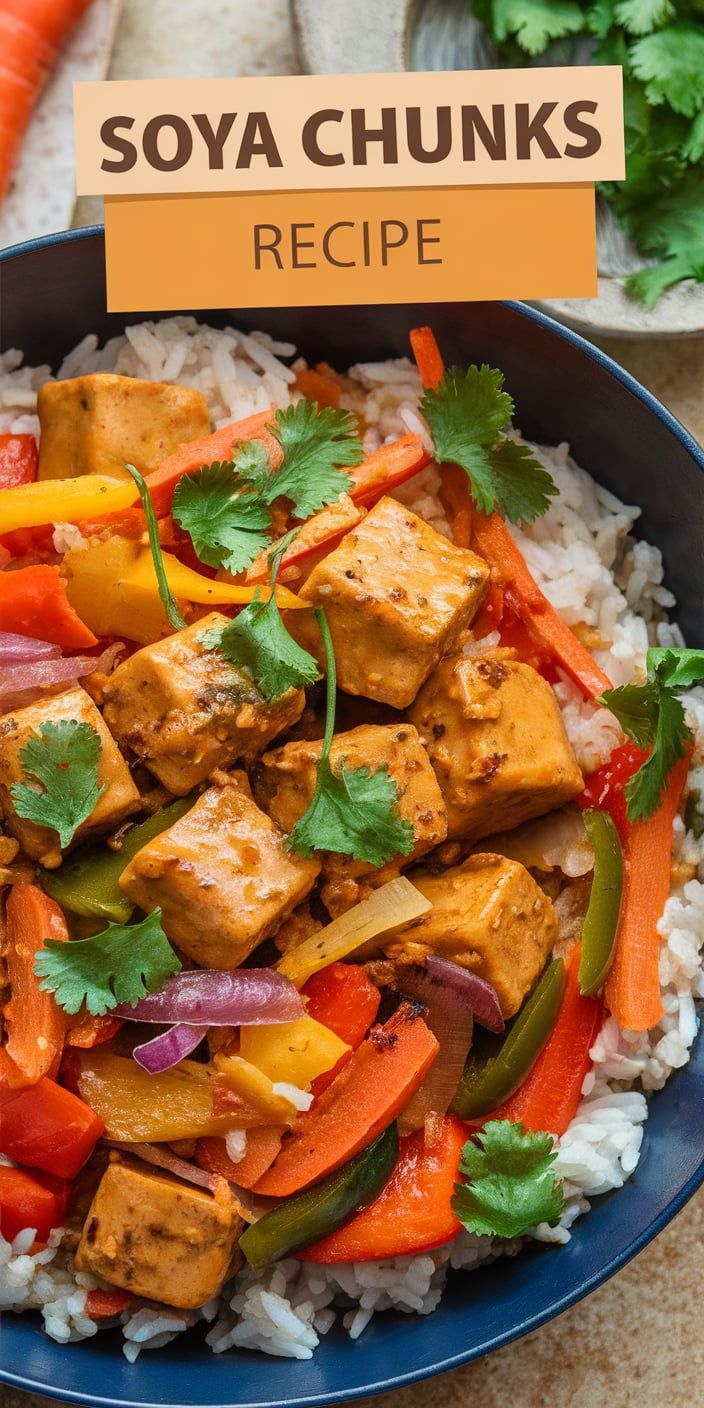Discovering the perfect soya chunks recipe has been a game-changer in my kitchen. As someone always on the lookout for nutritious meat alternatives, I’ve fallen in love with these incredible protein-packed morsels that transform any meal into a satisfying experience.
Soya chunks are more than just a vegetarian protein source – they’re a culinary adventure waiting to happen. My journey with this meat alternative began when I was searching for ways to add more plant-based nutrition to my diet without sacrificing flavor or texture.
Whether you’re a committed vegetarian or simply exploring new protein options, this soya chunks recipe will revolutionize your cooking. These versatile nuggets absorb flavors beautifully, making them an ideal ingredient for countless dishes.
In the following sections, I’ll walk you through everything you need to know about preparing mouth-watering soya chunks that will impress even the most dedicated meat lovers. Get ready to discover a world of delicious, protein-rich meals that are both healthy and incredibly tasty.

What Are Soya Chunks and Their Nutritional Benefits
Soya chunks have emerged as a powerhouse of nutrition for vegetarian protein sources. These meat alternatives pack a remarkable punch of essential nutrients that can transform your dietary approach. As someone passionate about healthy eating, I’ve discovered how these plant-based protein sources can dramatically improve nutritional intake.
Soya chunks nutrition offers an impressive array of health benefits that make them a standout choice for plant-based diets. Let’s dive into what makes these protein-rich morsels so special.
Protein Content and Essential Nutrients
Packed with soy protein benefits, soya chunks deliver an exceptional nutritional profile:
- High protein content (approximately 50-55 grams per 100 grams)
- Rich in essential amino acids
- Low in saturated fat
- Excellent source of iron and calcium
Health Benefits for Vegetarians and Vegans
For those following plant-based diets, soya chunks provide critical nutritional support. They help address potential protein deficiencies while offering multiple health advantages.
| Nutrient | Amount per 100g | Percentage of Daily Value |
|---|---|---|
| Protein | 52g | 104% |
| Iron | 5.4mg | 30% |
| Calcium | 350mg | 35% |
Comparing Soya Chunks to Other Protein Sources
When evaluating vegetarian protein sources, soya chunks stand out for their comprehensive nutritional profile. Compared to other plant-based proteins, they offer a more complete amino acid composition and higher protein concentration.
- More protein per serving than most beans
- Lower calorie count compared to meat alternatives
- Versatile in cooking and preparation
By incorporating soya chunks into your diet, you’re choosing a nutrient-dense food that supports overall health and provides substantial protein for active lifestyles.
Essential Ingredients for Perfect Soya Chunks Recipe
When cooking with soya chunks, having the right ingredients makes all the difference. I’ll walk you through the essential components that transform simple soya chunks into a delicious and nutritious meal.
For your soya chunks ingredients, you’ll want to gather these key items:
- Dried soya chunks (textured vegetable protein)
- Warm water for rehydration
- Salt for seasoning
- Cooking oil (preferably vegetable or olive oil)
Spices play a crucial role in elevating the flavor of soya chunks. I recommend keeping these in your pantry:
- Turmeric powder
- Red chili powder
- Garam masala
- Cumin powder
- Garlic powder
To create a complete dish, consider adding fresh ingredients that complement soya chunks:
- Onions
- Tomatoes
- Green bell peppers
- Fresh cilantro for garnishing
When cooking with soya chunks, having these ingredients prepared will help you create a flavorful and protein-rich meal that satisfies both vegetarians and meat lovers alike.
How to Prepare and Soak Soya Chunks
Preparing soya chunks is a critical step in creating delicious plant-based meals. Proper soaking techniques can transform these protein-packed ingredients from dry and tough to tender and flavorful. I’ll walk you through the essential steps of soya chunks preparation to ensure you get the best results every time.
When it comes to soaking soya chunks, the process is straightforward but requires attention to detail. I recommend following these key steps:
- Use warm water for faster and more effective soaking
- Soak chunks for 15-20 minutes to achieve optimal softness
- Squeeze out excess water after soaking to prevent waterlogged texture
Proper Soaking Techniques
The secret to perfect soya chunks lies in the soaking method. I always start by boiling water and adding a pinch of salt to enhance flavor during the soaking process. Place the dry soya chunks in a bowl and cover them completely with hot water. Let them sit until they expand and become soft to the touch.
Tips for Achieving the Right Texture
Achieving the right texture is crucial in soya chunks preparation. Avoid over-soaking, which can make the chunks mushy. Gently squeeze out excess water using your hands or a clean kitchen towel. The ideal soya chunk should be soft yet firm enough to hold its shape in your recipe.
Common Soaking Mistakes to Avoid
I’ve learned some key mistakes to prevent during soaking soya chunks. Don’t use cold water, as it slows down the absorption process. Never skip squeezing out excess water, which can dilute the flavor and create a watery texture. Always rinse the chunks after soaking to remove any residual salt or off-flavors.
Basic Soya Chunks Recipe with Indian Spices
Creating a delicious Indian soya chunks recipe is easier than you might think. I’ll walk you through a simple yet flavorful spiced soya chunks preparation that will transform these protein-packed morsels into a mouthwatering meal.
Let’s start by gathering the essential ingredients for our spiced soya chunks:
- 2 cups dried soya chunks
- 1 large onion, finely chopped
- 2 tomatoes, diced
- 3 garlic cloves, minced
- 1-inch ginger, grated
- Indian spice blend (garam masala, turmeric, red chili powder)
- Salt to taste
- 2 tablespoons cooking oil
Here’s my step-by-step method for preparing authentic Indian soya chunks:
- Soak soya chunks in hot water for 15 minutes, then drain and squeeze out excess water
- Heat oil in a pan and sauté onions until golden brown
- Add ginger, garlic, and tomatoes, cooking until soft
- Sprinkle spices and mix thoroughly
- Add soya chunks and cook for 8-10 minutes
- Garnish with fresh cilantro
Pro tip: The key to incredible spiced soya chunks is allowing the spices to bloom and coat each piece evenly. This ensures maximum flavor in every bite of your Indian soya chunks recipe.
Your delectable soya chunks are now ready to serve! This recipe serves 3-4 people and takes approximately 30 minutes from start to finish.
Cooking Equipment and Kitchen Tools Needed
Preparing delicious soya chunks requires the right kitchen equipment. I’ll walk you through the essential cooking tools for soya chunks and help you understand which kitchen equipment can make your cooking process smoother and more enjoyable.
When it comes to cooking soya chunks, having the right utensils can transform your culinary experience. The key is to have versatile and reliable kitchen tools that make preparation easy and efficient.
Essential Utensils for Preparation
Here are the must-have cooking tools for soya chunks:
- Large mixing bowl for soaking and rinsing
- Sharp kitchen knife for chopping
- Cutting board
- Colander or strainer
- Measuring cups and spoons
Optional Tools for Enhanced Results
While not absolutely necessary, these kitchen equipment items can elevate your soya chunks cooking:
- Food processor for quick chopping
- Pressure cooker for faster cooking
- Non-stick skillet for even heating
- Digital kitchen scale for precise measurements
I recommend investing in quality kitchen equipment that can handle multiple cooking tasks. Stainless steel and non-stick utensils work best for preparing soya chunks, ensuring easy cooking and simple cleanup.
Tips for Making Soya Chunks Taste Amazing
Transforming soya chunks into a delicious meal requires some culinary creativity. I’ll share my top strategies for flavoring soya chunks that will elevate your tasty soya chunks recipe from ordinary to extraordinary.
Marinating is the secret weapon for creating mouth-watering soya chunks. Try these flavor-packed techniques:
- Soak soya chunks in a blend of yogurt, ginger-garlic paste, and aromatic spices for 30 minutes
- Use tandoori masala for an authentic Indian restaurant-style flavor
- Experiment with international marinades like Thai, Mexican, or Mediterranean spice blends
Cooking methods can dramatically improve the texture and taste of soya chunks. I recommend these techniques:
- Roast chunks in a cast-iron skillet for a crispy exterior
- Grill soya chunks to add smoky depth
- Stir-fry with high-heat vegetables for maximum flavor absorption
Seasoning is crucial for creating a tasty soya chunks recipe. Here are my favorite flavor combinations:
| Cuisine Style | Key Seasonings | Recommended Dishes |
|---|---|---|
| Indian | Garam masala, turmeric, cumin | Soya chunk curry |
| Chinese | Soy sauce, sesame oil, garlic | Stir-fried soya chunks |
| Italian | Basil, oregano, tomato sauce | Soya chunk pasta |
By implementing these flavoring techniques, you’ll transform soya chunks from bland to grand. The key is experimenting and finding your unique taste profile.
Storage and Meal Prep Recommendations
Storing soya chunks correctly is crucial for maintaining their quality and extending their shelf life. I’ll share some practical tips to help you master meal prep with soya chunks and keep them fresh and delicious.
Proper Storage Methods
When storing soya chunks, follow these essential guidelines to preserve their texture and flavor:
- Cool cooked soya chunks completely before storing
- Use airtight containers to prevent moisture and bacterial growth
- Refrigerate within 2 hours of cooking
- Store in the refrigerator for up to 3-4 days
Refrigeration and Freezing Strategies
I recommend the following storage approach for your soya chunks:
| Storage Method | Duration | Best Practices |
|---|---|---|
| Refrigerator | 3-4 days | Store in sealed container with minimal liquid |
| Freezer | Up to 2 months | Use freezer-safe containers or zip-lock bags |
Reheating Guidelines
Meal prep with soya chunks becomes easier when you know the right reheating techniques:
- Microwave: Heat in 30-second intervals, stirring between each
- Stovetop: Warm in a pan with a little water or sauce
- Avoid repeated reheating to maintain texture
By following these storage and reheating recommendations, you’ll ensure your soya chunks remain tasty and nutritious throughout the week. Proper storing soya chunks techniques will help you create delicious, convenient meals with minimal effort.
Variations and Creative Serving Suggestions
Experimenting with soya chunks recipes can transform your meal preparation from ordinary to extraordinary. I love exploring different culinary approaches that make these protein-packed morsels shine in various dishes. From Mexican-inspired tacos to Asian stir-fries, soya chunks offer incredible versatility for home cooks looking to expand their recipe repertoire.
When serving soya chunks, consider global flavor profiles to keep meals exciting. A Mediterranean-style salad with marinated soya chunks, crisp vegetables, and a zesty lemon dressing can be a refreshing lunch option. For those craving comfort food, try incorporating soya chunks into hearty pasta dishes or as a protein-rich filling for wraps and sandwiches.
My favorite technique involves marinating soya chunks in different spice blends before cooking. Indian, Thai, and Mexican seasonings can dramatically change the taste profile, making each meal feel like a new culinary adventure. Quick meal ideas like soya chunk salad bowls or protein-packed grain bowls provide nutritious options for busy weeknights.
Don’t be afraid to get creative with your soya chunks recipes. Whether you’re preparing a quick weeknight dinner or hosting a weekend gathering, these adaptable protein sources can easily become the star of your meal. The key is experimenting and finding flavor combinations that excite your taste buds.
